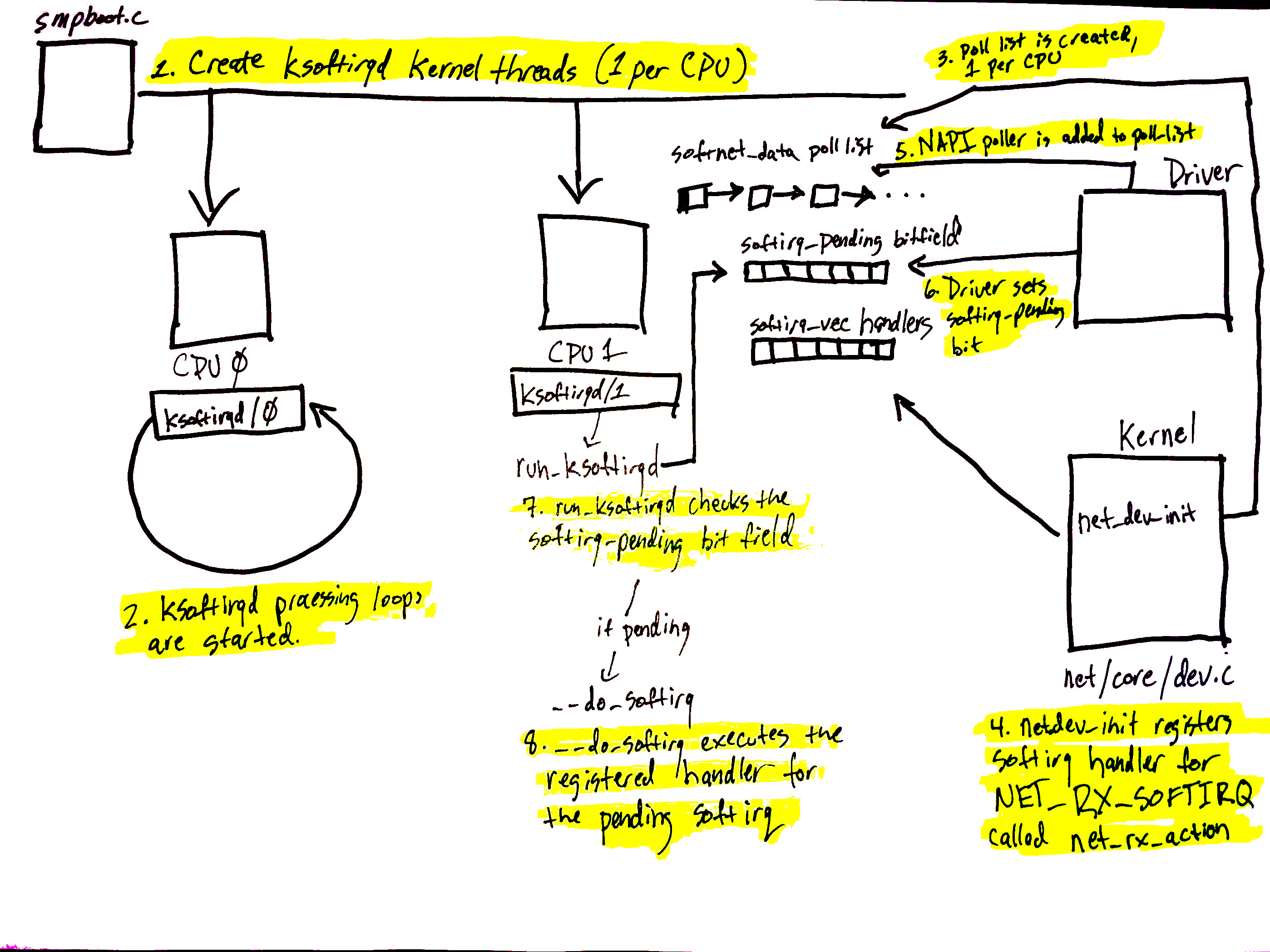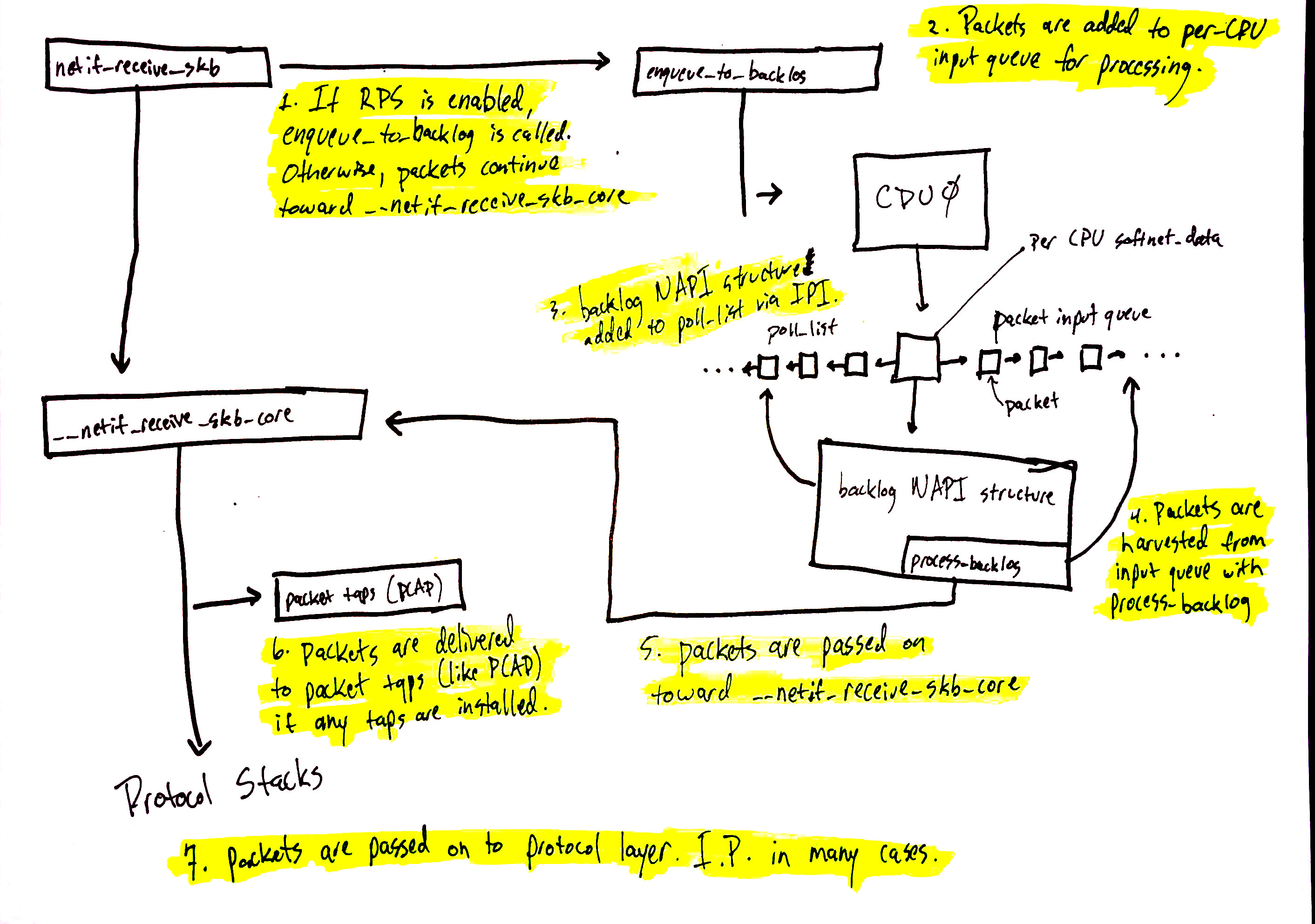Linux Network Performance Ultimate Guide
The following content is from my #til github.
Source
- https://github.com/leandromoreira/linux-network-performance-parameters/
- https://access.redhat.com/sites/default/files/attachments/20150325_network_performance_tuning.pdf
- https://www.coverfire.com/articles/queueing-in-the-linux-network-stack/
- https://blog.cloudflare.com/how-to-achieve-low-latency/
- https://blog.cloudflare.com/how-to-receive-a-million-packets/
- https://beej.us/guide/bgnet/html/
- https://blog.csdn.net/armlinuxww/article/details/111930788
- https://www.ibm.com/docs/en/linux-on-systems?topic=recommendations-network-performance-tuning
Linux Networking stack
Source:
https://blog.packagecloud.io/monitoring-tuning-linux-networking-stack-receiving-data/
https://blog.packagecloud.io/monitoring-tuning-linux-networking-stack-sending-data/
https://medium.com/coccoc-engineering-blog/linux-network-ring-buffers-cea7ead0b8e8
The complete network data flow:

- It’s a getting started. Before perform any tuning, let make sure that we understand how computers running Linux receive packets.
- Linux queue:

NOTE: The follow sections will heavily use sysctl. If you don’t familiar with this command, take a look at HOWTO#sysctl section.
Linux network packet reception
You check the detailed version at PackageCloud’s article.
Click to expand
- In network devices, it is common for the NIC to raise an **IRQ** to signal that a packet has arrived and is ready to be processed. - An IRQ (Interrupt Request) is a hardware signal sent to the processor instructing it to suspend its current activity and handle some external event, such as a keyboard input or a mouse movement. - In Linux, IRQ mappings are stored in **/proc/interrupts**. - When an IRQ handler is executed by the Linux kernel, it runs at a very, very high priority and often blocks additional IRQs from being generated. As such, IRQ handlers in device drivers must execute as quickly as possible and defer all long running work to execute outside of this context. This is why the **softIRQ** system exists. - **softIRQ** system is a system that kernel uses to process work outside of the device driver IRQ context. In the case of network devices, the softIRQQ system is responsible for processing incoming packetsInitial setup (from step 1-4):
- softIRQ kernel threads are created (1 per CPU).
- The ksoftirqd threads begin executing their processing loops.
softnet_datastructures are created (1 per CPU), hold references to important data for processing network data.poll_listis created (1 per CPU).net_dev_initthen registers theNET_RX_SOFTIRQsoftirq with the softirq system by callingopen_softirq- this registration is callednet_rx_action,
Alright, Linux just init and setup networking stack to wait for data arrival:
- Data is received by the NIC (Network Interface Card) from the network.
- The NIC uses DMA (Direct Memory Access) to write the network data to RAM (in ring buffer).
- Some NICs are “multiqueue” NICs, meaning that they can DMA incoming packets to one of many ring buffers in RAM.
- The NIC raises an IRQ.
- The device driver’s registered IRQ handler is executed.
- The IRQ is cleared on the NIC, so that it can generate IRQs for net packet arrivals.
- NAPI softIRQ poll loop is started with a call to
napi_schedule.
Check initial setup diagram (setup 5-8):
- The call to
napi_schedulein the driver adds the driver’s NAPI poll structure to thepoll_listfor the current CPU. - The softirq pending a bit is set so that the
ksoftirqdprocess on this CPU knows that there are packets to process. run_ksoftirqdfunction (which is being run in a loop by theksoftirqkernel thread) executes.__do_softirqis called which checks the pending bitfield, sees that a softIRQ is pending, and calls the handler registerd for the pending softIRQ:net_rx_action(softIRQ kernel thread executes this, not the driver IRQ handler).
- The call to
Now, data processing begins:
net_rx_actionloop starts by checking the NAPI poll list for NAPI structures.- The
budgetand elapsed time are checked to ensure that the softIRQ will not monopolize CPU time. - The registered
pollfunction is called. - The driver’s
pollfunctio harvests packets from the ring buffer in RAM. - Packets are handed over to
napi_gro_receive(GRO - Generic Receive Offloading).- GRO is a widely used SW-based offloading technique to reduce per-packet processing overheads.
- By reassembling small packets into larger ones, GRO enables applications to process fewer large packets directly, thus reducing the number of packets to be processed.
- Packets are either held for GRO and the call chain ends here or packets are passed on to
netif_receive_skbto proceed up toward the protocol stacks.
Network data processing continues from
netif_receive_skb, but the path of the data depends on whether or not Receive Packet Steering (RPS) is enabled or not.- If RPS is disabled:
netif_receive_skbpassed the data onto__netif_receive_core.
__netif_receive_coredelivers the data to any taps.
__netif_receive_coredelivers data to registed protocol layer handlers.
- If RPS is enabled:
netif_receive_skbpasses the data on toenqueue_to_backlog.
- Packets are placed on a per-CPU input queue for processing.
- The remote CPU’s NAPI structure is added to that CPU’s poll_list and an IPI is queued which will trigger the softIRQ kernel thread on the remote CPU to wake-up if it is not running already.
- When the
ksoftirqdkernel thread on the remote CPU runs, it follows the same pattern describe in the previous section, but this time, the registered poll function isprocess_backlogwhich harvests packets from the current CPU’s input queue.
- When the
- Packets are passed on toward
__net_receive_skb_core.
- Packets are passed on toward
__netif_receive_coredelivers data to any taps (like PCAP).
__netif_receive_coredelivers data to registered protocol layer handlers.
- If RPS is disabled:
Protocol stacks, netfilter, BPF, and finally the userland socket.
- Packets are received by the IPv4 protocol layer with
ip_rcv. - Netfilter and a routing optimization are performed.
- Data destined for the current system is delivered to higher-level protocol layers, like UDP.
- Packets are received by the UDP protocol layer with
udp_rcvand are queued to the receive buffer of a userland socket byudp_queue_rcv_skbandsock_queue_rcv. Prior to queuing to the receive buffer, BPF are processed.
- Packets are received by the IPv4 protocol layer with
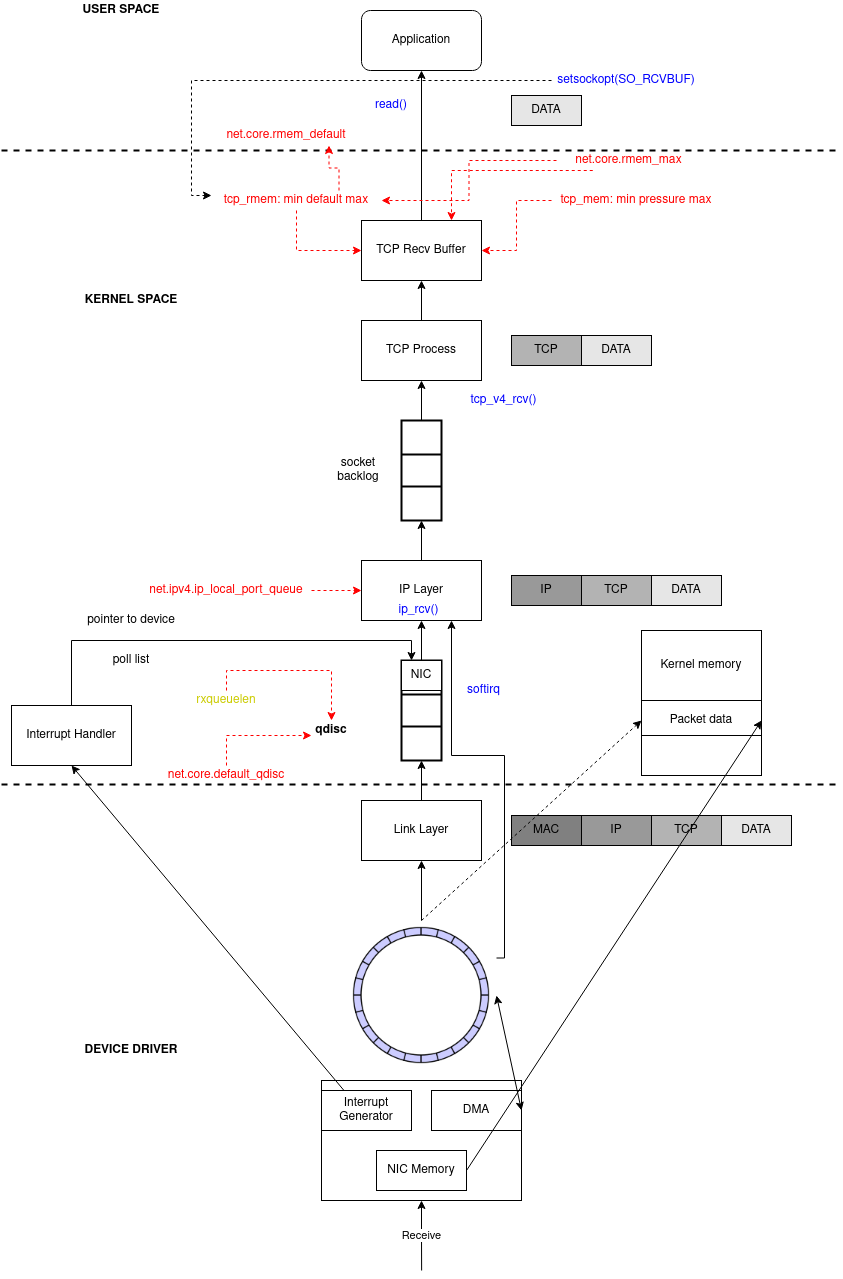

NOTE: Some NICs are “multiple queues” NICs. This diagram above shows just a single ring buffer for simplicity, but depending on the NIC you are using and your hardware settings you may have mutliple queues in the system. Check Share the load of packet processing among CPUs section for detail.
Packet arrives at the NIC
NIC verifies
MAC(if not on promiscuous mode) andFCSand decide to drop or to continueNIC does DMA (Direct Memory Access) packets into RAM - in a kernel data structure called an
sk_bufforskb(Socket Kernel Buffers - SKBs).NIC enqueues references to the packets at receive ring buffer queue
rxuntilrx-usecstimeout orrx-frames. Let’s talk about the RX ring buffer:- It is a circular buffer where an overflow simply overwrites existing data.
- It does not contain packet data. Instead it consists of descriptors which point to
skbswhich is DMA into RAM (step 2).

- Fixed size, FIFO and located at RAM (of course).
NIC raises a
HardIRQ- Hard Interrupt.HardIRQ: interrupt from the hardware, known-as “top-half” interrupts.- When a NIC receives incoming data, it copies the data into kernel buffers using DMA. The NIC notifies the kernel of this data by raising a HardIRQ. These interrupts are processed by interrupt handlers which do minimal work, as they have already interrupted another task and cannot be interrupted themselves.
- HardIRQs can be expensive in terms of CPU usage, especially when holding kernel locks. If they take too long to execute, they will cause the CPU to be unable to respond to other HardIRQ, so the kernel introduces
SoftIRQs(Soft Interrupts), so that the time-consuming part of the HardIRQ handler can be moved to the SoftIRQ handler to handle it slowly. We will talk about SoftIRQ in the next steps. - HardIRQs can be seen in
/proc/interruptswhere each queue has an interrupt vector in the 1st column assigned to it. These are initialized when the system boots or when the NIC device driver module is loaded. Each RX and TX queue is assigned a unique vector, which informs the interrupt handler as to which NIC/queue the interrupt is coming from. The columns represent the number of incoming interrupts as a counter value:
egrep “CPU0|eth3” /proc/interrupts CPU0 CPU1 CPU2 CPU3 CPU4 CPU5 110: 0 0 0 0 0 0 IR-PCI-MSI-edge eth3-rx-0 111: 0 0 0 0 0 0 IR-PCI-MSI-edge eth3-rx-1 112: 0 0 0 0 0 0 IR-PCI-MSI-edge eth3-rx-2 113: 2 0 0 0 0 0 IR-PCI-MSI-edge eth3-rx-3 114: 0 0 0 0 0 0 IR-PCI-MSI-edge eth3-txCPU runs the
IRQ handlerthat runs the driver’s code.Driver will schedule a NAPI, clear the HardIRQ on the NIC, so that it can generate IRQs for new packets arrivals.
Driver raise a
SoftIRQ (NET_RX_SOFTIRQ).- Let’s talk about the
SoftIRQ, also known as “bottom-half” interrupt. It is a kernel routines which are scheduled to run at a time when other tasks will not be interrupted. - Purpose: drain the network adapter receive Rx ring buffer.
- These routines run in the form of
ksoftirqd/cpu-numberprocesses and call driver-specific code functions. - Check command:
ps aux | grep ksoftirq # ksotirqd/<cpu-number> root 13 0.0 0.0 0 0 ? S Dec13 0:00 [ksoftirqd/0] root 22 0.0 0.0 0 0 ? S Dec13 0:00 [ksoftirqd/1] root 28 0.0 0.0 0 0 ? S Dec13 0:00 [ksoftirqd/2] root 34 0.0 0.0 0 0 ? S Dec13 0:00 [ksoftirqd/3] root 40 0.0 0.0 0 0 ? S Dec13 0:00 [ksoftirqd/4] root 46 0.0 0.0 0 0 ? S Dec13 0:00 [ksoftirqd/5]- Monitor command:
watch -n1 grep RX /proc/softirqs watch -n1 grep TX /proc/softirqs- Let’s talk about the
NAPI polls data from the rx ring buffer.
- NAPI was written to make processing data packets of incoming cards more efficient. HardIRQs are expensive because they can’t be interrupt, we both known that. Even with Interrupt coalesecense (describe later in more detail), the interrupt handler will monopolize a CPU core completely. The design of NAPI allows the driver to go into a polling mode instead of being HardIRQ for every required packet receive.
- Step 1->9 in brief:

The polling routine has a budget which determines the CPU time the code is allowed, by using
netdev_budget_usecstimeout ornetdev_budgetanddev_weightpackets. This is required to prevent SoftIRQs from monopolizing the CPU. On completion, the kernel will exit the polling routine and re-arm, then the entire procedure will repeat itself.Let’s talk about
netdev_budget_usecstimeout ornetdev_budgetanddev_weightpackets:If the SoftIRQs do not run for long enough, the rate of incoming data could exceed the kernel’s capability to drain the buffer last enough. As a result, the NIC buffers will overflow and traffic will be lost. Occasionaly, it is necessary to increase the time that SoftIRQs are allowed to run on the CPU. This is known as the
netdev_budget.- Check command, the default value is 300, it means the SoftIRQ process to drain 300 messages from the NIC before getting off the CPU.
sysctl net.core.netdev_budget net.core.netdev_budget = 300netdev_budget_usecs: The maximum number of microseconds in 1 NAPI polling cycle. Polling will exit when eithernetdev_budget_usecshave elapsed during the poll cycle or the number of packets processed reachesnetdev_budget.- Check command:
sysctl net.core.netdev_budget_usecs net.core.netdev_budget_usecs = 8000dev_weight: the maximum number of packets that kernel can handle on a NAPI interrupt, it’s a PER-CPU variable. For drivers that support LRO or GRO_HW, a hardware aggregated packet is counted as one packet in this.
sysctl net.core.dev_weight net.core.dev_weight = 64
Linux also allocates memory to
sk_buff.Linux fills the metadata: protocol, interface, setmatchheader, removes ethernet
Linux passes the skb to the kernel stack (
netif_receive_skb)It sets the network header, clone
skbto taps (i.e. tcpdump) and pass it to tc ingressPackets are handled to a qdisc sized
netdev_max_backlogwith its algorithm defined bydefault_qdisc:netdev_max_backlog: a queue whitin the Linux kernel where traffic is stored after reception from the NIC, but before processing by the protocols stacks (IP, TCP, etc). There is one backlog queue per CPU core. A given core’s queue can grow automatically, containing a number of packets up to the maximum specified by thenetdev_max_backlogsettings.- In other words, this is the maximum number of packets, queued on the INPUT side (the ingress dsic), when the interface receives packets faster than kernel can process them.
- Check command, the default value is 1000.
sysctl net.core.netdev_max_backlog net.core.netdev_max_backlog = 1000rxqueuelen: Receipt Queue Length, is a TCP/IP stack network interface value that sets the number of packets allowed per kernel receive queue of a network interface device.- By default, value is 1000 (depend on network interface driver):
ifconfig <interface> | grep rxqueuelen
- By default, value is 1000 (depend on network interface driver):
default_qdisc: the default queuing discipline to use for network devices. This allows overriding the default of pfifo_fast with an alternative. Since the default queuing discipline is created without additional parameters so is best suited to queuing disciplines that work well without configuration like stochastic fair queue (sfq), CoDel (codel) or fair queue CoDel (fq_codel). For full details for each QDisc inman tc <qdisc-name>(for example,man tc fq_codel).
It calls
ip_rcvand packets are handled to IPIt calls netfilter (
PREROUTING)It looks at the routing table, if forwarding or local
If it’s local it calls netfilter (
LOCAL_IN)It calls the L4 protocol (for instance
tcp_v4_rcv)It finds the right socket
It goes to the tcp finite state machine
Enqueue the packet to the receive buffer and sized as
tcp_rmemrules- If `tcp_moderate_rcvbuf is enabled kernel will auto-tune the receive buffer
tcp_rmem: Contains 3 values that represent the minimum, default and maximum size of the TCP socket receive buffer.- min: minimal size of receive buffer used by TCP sockets. It is guaranteed to each TCP socket, even under moderate memory pressure. Default: 4 KB.
- default: initial size of receive buffer used by TCP sockets. This value overrides
net.core.rmem_defaultused by other protocols. Default: 131072 bytes. This value results in initial window of 65535. - max: maximal size of receive buffer allowed for automatically selected receiver buffers for TCP socket. This value does not override
net.core.rmem_max. Callingsetsockopt()withSO_RCVBUFdisables automatic tuning of that socket’s receive buffer size, in which case this value is ignored.SO_RECVBUFsets the fixed size of the TCP receive buffer, it will overridetcp_rmem, and the kernel will no longer dynamically adjust the buffer. The maximum value set bySO_RECVBUFcannot exceednet.core.rmem_max. Normally, we will not use it. Default: between 131072 and 6MB, depending on RAM size.
net.core.rmem_max: the upper limit of the TCP receive buffer size.- Between
net.core.rmem_maxandnet.ipv4.tcp-rmem‘max value, the bigger value takes precendence. - Increase this buffer to enable scaling to a larger window size. Larger windows increase the amount of data to be transferred before an acknowledgement (ACK) is required. This reduces overall latencies and results in increased throughput.
- This setting is typically set to a very conservative value of 262,144 bytes. It is recommended this value be set as large as the kernel allows. 4.x kernels accept values over 16 MB.
- Between
Kernel will signalize that there is data available to apps (epoll or any polling system)
Application wakes up and reads the data
Linux kernel network transmission
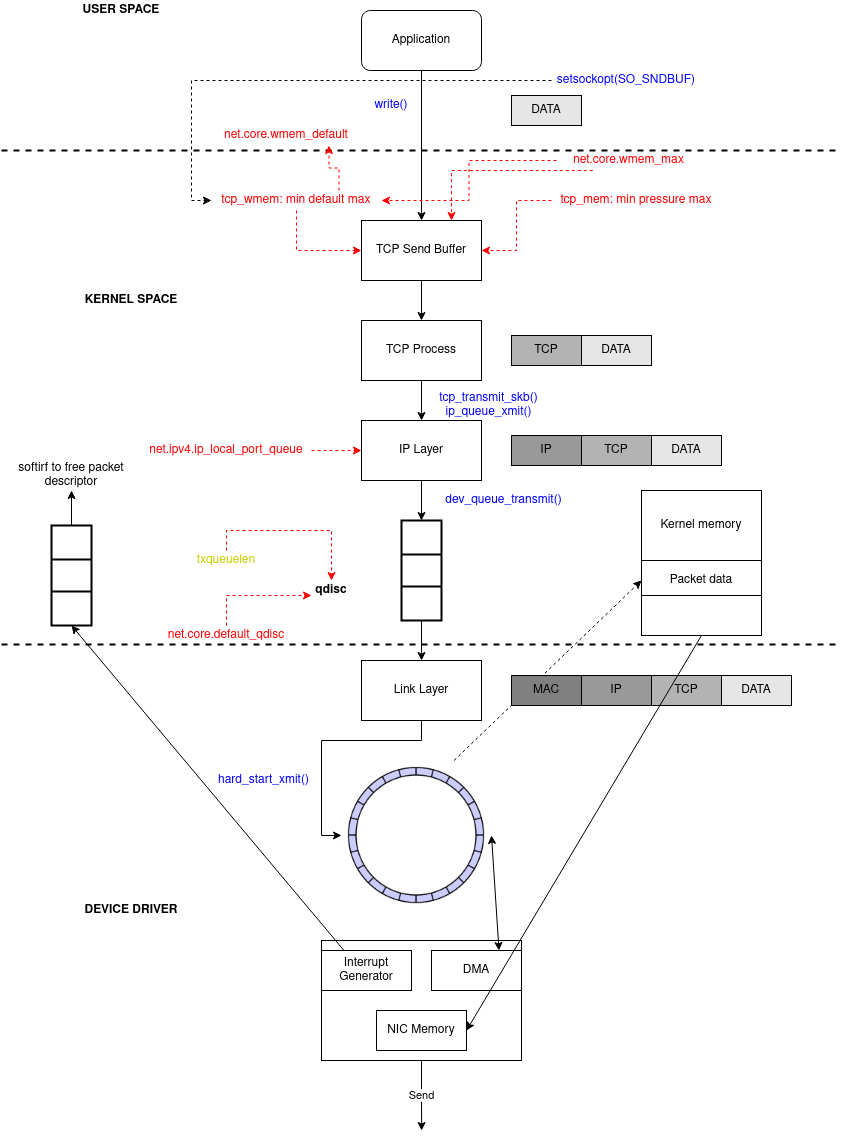

Although simpler than the ingress logic, the egress is still worth acknowledging
Application sends message (
sendmsgor other)TCP send message allocates skb_buff
It enqueues skb to the socket write buffer of
tcp_wmemsizetcp_wmem: Contains 3 values that represent the minimum, default and maximum size of the TCP socket send buffer.- min: amount of memory reserved for send buffers for TCP sockets. Each TCP socket has rights to use it due to fact of its birth. Default: 4K
- default: initial size of send buffer used by TCP sockets. This value overrides net.core.wmem_default used by other protocols. It is usually lower than
net.core.wmem_default. Default: 16K - max: maximal amount of memory allowed for automatically tuned send buffers for TCP sockets. This value does not override net.core.wmem_max. Calling
setsockopt()withSO_SNDBUFdisables automatic tuning of that socket’s send buffer size, in which case this value is ignored.SO_SNDBUFsets the fixed size of the send buffer, it will overridetcp_wmem, and the kernel will no longer dynamically adjust the buffer. The maximum value set by SO_SNDBUF cannot exceednet.core.wmem_max. Normally, we will not use it. Default: between 64K and 4MB, depending on RAM size.
- Check command:
sysctl net.ipv4.tcp_wmem net.ipv4.tcp_wmem = 4096 16384 262144- The size of the TCP send buffer will be dynamically adjusted between min and max by the kernel. The initial size is default.
net.core.wmem_max: the upper limit of the TCP send buffer size. Similar tonet.core.rmem_max(but for transimission).
Builds the TCP header (src and dst port, checksum)
Calls L3 handler (in this case
ipv4ontcp_write_xmitandtcp_transmit_skb)L3 (
ip_queue_xmit) does its work: build ip header and call netfilter (LOCAL_OUT)Calls output route action
Calls netfilter (
POST_ROUTING)Fragment the packet (
ip_output)Calls L2 send function (
dev_queue_xmit)Feeds the output (QDisc) queue of
txqueuelenlength with its algorithmdefault_qdisctxqueuelen: Transmit Queue Length, is a TCP/IP stack network interface value that sets the number of packets allowed per kernel transmit queue of a network interface device.- By default, value is 1000 (depend on network interface driver):
ifconfig <interface> | grep txqueuelen
- By default, value is 1000 (depend on network interface driver):
default_qdisc: the default queuing discipline to use for network devices. This allows overriding the default of pfifo_fast with an alternative. Since the default queuing discipline is created without additional parameters so is best suited to queuing disciplines that work well without configuration like stochastic fair queue (sfq), CoDel (codel) or fair queue CoDel (fq_codel). For full details for each QDisc inman tc <qdisc-name>(for example,man tc fq_codel).
The driver code enqueue the packets at the
ring buffer txThe driver will do a
soft IRQ (NET_TX_SOFTIRQ)aftertx-usecstimeout ortx-framesRe-enable hard IRQ to NIC
Driver will map all the packets (to be sent) to some DMA’ed region
NIC fetches the packets (via DMA) from RAM to transmit
After the transmission NIC will raise a
hard IRQto signal its completionThe driver will handle this IRQ (turn it off)
And schedule (
soft IRQ) the NAPI poll systemNAPI will handle the receive packets signaling and free the RAM
Network Performance tuning
Tuning a NIC for optimum throughput and latency is a complex process with many factors to consider. There is no generic configuration that can be broadly applied to every system.
There are factors should be considered for network performance tuning. Note that, the interface card name may be different in your device, change the appropriate value.
Ok, let’s follow through the Packet reception (and transmission) and do some tuning.
Quick HOWTO
/proc/net/softnet_stat & /proc/net/sockstat
Before we continue, let’s discuss about /proc/net/softnet_stat & /proc/net/sockstat as these files will be used a lot then.
cat /proc/net/softnet_stat
0000272d 00000000 00000000 00000000 00000000 00000000 00000000 00000000 00000000 00000000 00000000 00000000 00000000
000034d9 00000000 00000000 00000000 00000000 00000000 00000000 00000000 00000000 00000000 00000000 00000000 00000001
00002c83 00000000 00000000 00000000 00000000 00000000 00000000 00000000 00000000 00000000 00000000 00000000 00000002
0000313d 00000000 00000000 00000000 00000000 00000000 00000000 00000000 00000000 00000000 00000000 00000000 00000003
00003015 00000000 00000001 00000000 00000000 00000000 00000000 00000000 00000000 00000000 00000000 00000000 00000004
000362d2 00000000 000000d2 00000000 00000000 00000000 00000000 00000000 00000000 00000000 00000000 00000000 00000005
- Each line of the softnet_stat file represents a CPU core starting from CPU0.
- The statistics in each column are provided in hexadecimal
- 1st column is the number of frames received by the interrupt handler.
- 2nd column is the number of frames dropped due to
netdev_max_backlogbeing exceeded. - 3rd column is the number of times ksoftirqd ran out of
netdev_budgetor CPU time when there was still work to be done. - The other columns may vary depending on the Linux version.
cat /proc/net/sockstat
sockets: used 937
TCP: inuse 21 orphan 0 tw 0 alloc 22 mem 5
UDP: inuse 9 mem 5
UDPLITE: inuse 0
RAW: inuse 0
FRAG: inuse 0 memory 0
- Check
memfield. It is calculated simply by summingsk_buff->truesizefor all sockets. - More detail here
ss
ssis another utility to investigate sockets. It is used to dump socket statistics. It allows showing information similar tonetstat. IT can display more TCP and state information than other tools.- For more you should look at man page:
man ss. - For example, to check socket memory usage:
ss -tm
# -m, --memory
# Show socket memory usage. The output format is:
# skmem:(r<rmem_alloc>,rb<rcv_buf>,t<wmem_alloc>,tb<snd_buf>,
# f<fwd_alloc>,w<wmem_queued>,o<opt_mem>,
# bl<back_log>,d<sock_drop>)
# <rmem_alloc>
# the memory allocated for receiving packet
# <rcv_buf>
# the total memory can be allocated for receiving packet
# <wmem_alloc>
# the memory used for sending packet (which has been sent to layer 3)
# <snd_buf>
# the total memory can be allocated for sending packet
# <fwd_alloc>
# the memory allocated by the socket as cache, but not used for receiving/sending packet yet. If need memory to send/receive packet, the memory in this
# cache will be used before allocate additional memory.
# <wmem_queued>
# The memory allocated for sending packet (which has not been sent to layer 3)
# <ropt_mem>
# The memory used for storing socket option, e.g., the key for TCP MD5 signature
# <back_log>
# The memory used for the sk backlog queue. On a process context, if the process is receiving packet, and a new packet is received, it will be put into the
# sk backlog queue, so it can be received by the process immediately
# <sock_drop>
# the number of packets dropped before they are de-multiplexed into the socket
# -t, --tcp
# Display TCP sockets.
State Recv-Q Send-Q Local Address:Port Peer Address:Port
ESTAB 0 0 192.168.56.102:ssh 192.168.56.1:56328
skmem:(r0,rb369280,t0,tb87040,f0,w0,o0,bl0,d0)
# rcv_buf: 369280 bytes
# snd_buf: 87040 bytes
netstat
- A command-line utility which can print information about open network connections and protocol stack statistics. It retrieves information about the networking subsystem from the
/proc/net/file system. These files include:/proc/net/dev(device information)/proc/net/tcp(TCP socket information)/proc/net/unix(Unix domain socket information)
- For more information about
netstatand its referenced files from/proc/net/, refer to thenetstatman page:man netstat.
sysctl
- Rather than modifying system variables by
echo-ing values in the/procfile system directly:
echo "value" > /proc/sys/location/variable
- The
sysctlcommand is available to change system /network settings. It provides methods of overriding default settings values on a temporary basis for evaluation purposes as well as changing values permanently that persist across system restarts.
# To display a list of available sysctl variables
sysctl -a | less
# To only list specific variables use
sysctl variable1 [variable2] [...]
# To change a value temporarily use the sysctl command with the -w option:
sysctl -w variable=value
# To override the value persistently, the /etc/sysctl.conf file must be changed. This is the recommend method. Edit the /etc/sysctl.conf file.
vi /etc/sysctl.conf
# Then add/change the value of the variable
variable = value
# Save the changes and close the file. Then use the -p option of the sysctl command to load the updated sysctl.conf settings:
sysctl -p or sysctl -p /etc/sysctl.conf
# The updated sysctl.conf values will now be applied when the system restarts.
The NIC Ring Buffer
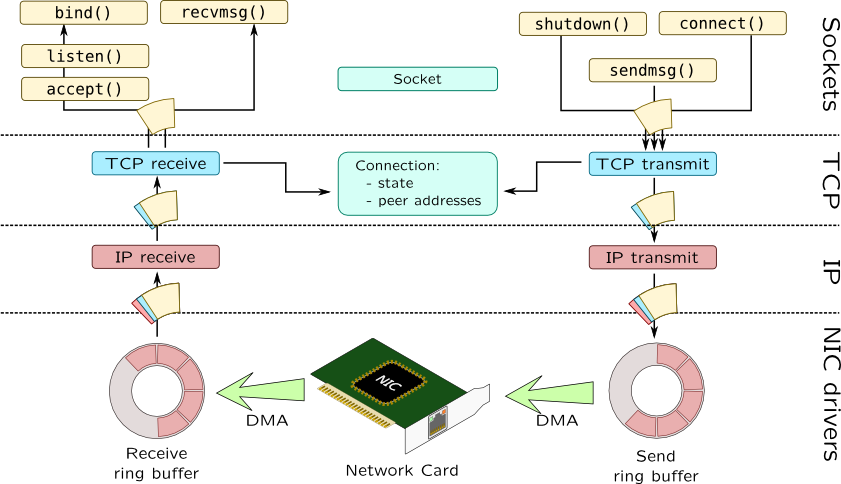
Firstly, check out step (4) - NIC Ring buffer. It’s a circular buffer, fixed size, FIFO, located at RAM. Buffer to smoothly accept bursts of connections without dropping them, you might need to increase these queues when you see drops or overrun, aka there are more packets coming than the kernel is able to consume them, the side effect might be increased latency.
Ring buffer’s size is commonly set to a smaller size then the maximum. Often, increasing the receive buffer size is alone enough to prevent packet drops, as it can allow the kernel slightly more time to drain the buffer.
- Check command:
ethtool -g eth3 Ring parameters for eth3: Pre-set maximums: RX: 8192 RX Mini: 0 RX Jumbo: 0 TX: 8192 Current hardware settings: RX: 1024 RX Mini: 0 RX Jumbo: 0 TX: 512 # eth3's inteface has the space for 8KB but only using 1KB- Change command:
# Increase both the Rx and Tx buffers to the maximum ethtool -G eth3 rx 8192 tx 8192Persist the value:
How to monitor:
ethtool -S eth3 | grep -e "err" -e "drop" -e "over" -e "miss" -e "timeout" -e "reset" -e "restar" -e "collis" -e "over" | grep -v "\: 0"
Interrupt Coalescence (IC) - rx-usecs, tx-usecs, rx-frames, tx-frames (hardware IRQ)
Move on to step (5), hard interrupt - HardIRQ. NIC enqueue references to the packets at receive ring buffer queue rx until rx-usecs timeout or rx-frames, then raises a HardIRQ. This is called Interrupt coalescence:
- The amount of traffic that a network will receive/transmit (number of frames)
rx/tx-frames, or time that passes after receiving/transmitting traffic (timeout)rx/tx-usecs.- Interrupting too soon: poor system performance (the kernel stops a running task to handle the hardIRQ)
- Interrupting too late: traffic isn’t taken off the NIC soon enough -> more traffic -> overwrite -> traffic loss!
- The amount of traffic that a network will receive/transmit (number of frames)
Updating Interrupt coalescence can reduce CPU usage, hardIRQ, might be increase throughput at cost of latency
Tuning:
- Check command:
- Adaptive mode enables the card to auto-moderate the IC. The driver will inspect traffic patterns and kernel receive patterns, and estimate coalescing settings on-the-fly which aim to prevent packet loss -> useful if many small packets are received.
- Higher interrupt coalescence favors bandwidth over latency: VOIP application (latency-sensitive) may require less coalescence than a file transfer (throughput-sensitive)
ethtool -c eth3 Coalesce parameters for eth3: Adaptive RX: on TX: off # Adaptive mdoe stats-block-usecs: 0 sample-interval: 0 pkt-rate-low: 400000 pkt-rate-high: 450000 rx-usecs: 16 rx-frames: 44 rx-usecs-irq: 0 rx-frames-irq: 0- Change command:
- Allow at least some packets to buffer in the NIC, and at least some time to pass, before interrupting the kernel. The values depend on system capabilities and traffic received.
# Turn adaptive mode off # Interrupt the kernel immediately upon reception of any traffic ethtool -C eth3 adaptive-rx off rx-usecs 0 rx-frames 0- How to monitor:
- Check command:
IRQ Affinity
- IRQs have an associated “affinity property”,
smp_affinity, which defines the CPU cores that are allowed to execute the Interrupt Service Routines (ISRs) for that IRQ. This property can be used to improve application performance by assigning both interrupt affinity and the application’s thread affinity to one or more specific CPU cores. This allows cache line sharing between the specified interrupt and application threads. - By default, it is controlled by
irqbalancerdaemon.
systemctl status irqbalance.service
- But it can also be manually balanced if desired to determine if
irqbalanceis not balancing IRQs in a optimum manner and therefore causing packet loss. There may be some very specific cases where manually balancing interrupts permanently can be beneficial. Before does this kind of tuning, make sure you stopirqbalance:
systemctl stop irqbalance.service
- The interrupt affinity value a particular IRQ number is stored in the associated
/proc/irq/<IRQ_NUMBER>/smp_affinityfile, which can be viewed and modified by the root user. The value stored in this file is a hexadecimal bit-mask representing all CPU cores in the system. - To set the interrupt affinity for the Ethernet driver on a server with 4 cores (for example):
# Determine the IRQ number associated with the Ethernet driver
grep eth0 /proc/interrupts
32: 0 140 45 850264 PCI-MSI-edge eth0
# IRQ 32
# Check the current value
# The default value is 'f', meaning that the IRQ can be serviced
# on any of the CPUs
cat /proc/irq/32/smp_affinity
f
# CPU0 is the only CPU used
echo 1 > /proc/irq/32/smp_affinity
cat /proc/irq/32/smp_affinity
1
# Commas can be used to delimit smp_affinity values for discrete 32-bit groups
# This is required on systems with more than 32 cores
# For example, IRQ 40 is serviced on all cores of a 64-core system
cat /proc/irq/40/smp_affinity
ffffffff,ffffffff
# To service IRQ 40 on only the upper 32 cores
echo 0xffffffff,00000000 > /proc/irq/40/smp_affinity
cat /proc/irq/40/smp_affinity
ffffffff,00000000
- Script to set IRQ affinity on Intel NICs, handles system with > 32 cores.
- As I said, IRQ affinity can improve performance but only in a very specific configuration with a pre-defined workload. It is a double edged sword.
Share the load of packet processing among CPUs
Source:
- http://balodeamit.blogspot.com/2013/10/receive-side-scaling-and-receive-packet.html
- https://garycplin.blogspot.com/2017/06/linux-network-scaling-receives-packets.html
- https://github.com/torvalds/linux/blob/master/Documentation/networking/scaling.rst
Once upon a time, everything was so simple. The network card was slow and had only one queue. When packets arrives, the network card copies packets through DMA and sends an interrupt, and the Linux kernel harvests those packets and completes interrupt processing. As the network cards became faster, the interrupt based model may cause IRQ storm due to the massive incoming packets. This will consume the most of CPU power and freeze the system. To solve this problem, NAPI (interrupt and polling) was proposed. When the kernel receives an interrupt from the network card, it starts to poll the device and harvest packets in the queues as fast as possible. NAPI works nicely with the 1Gbps network card which is common nowadays. However, it comes to 10Gbps, 20Gbps, or even 40Gbps network cards, NAPI may not be sufficient. Those cards would demand mush faster CPU if we still use one CPU and one queue to receive packets. Fortunately, multi-core CPUs are popular now, so why not process packets in parallel?
Receive-side scaling (RSS)
When packet arrives at NIC, they are added to receive queue. Receive queue is assigned an IRQ number during device drive initialization and one of the available CPU processor is allocated to that receive queue. This processor is responsible for servicing IRQs interrupt service routing (ISR). Generally the data processing is also done by same processor which does ISR.
If there is large amount of network traffic -> only single core is taking all responsibility of processing data. ISR routines are small so if they are being executed on single core does not make large difference in performance, but data processing and moving data up in TCP/IP stack takes time (other cores are idle).
- These pictures are from balodeamit blog
- IRQ 53 is used for “eth1-TxRx-0” mono queue.
- Check
smp_affinity-> queue was configured to send interrupts to CPU8.
.png)
RSS comes to rescue! RSS allow to configure network card to distributes across multiple send and receive queues (ring buffers). These queues are individually mapped to each CPU processor. When interrupts are generated for each queue, they are sent to mapped processor -> Network traffic is processed by multiple processors.
- 4 receive queues and 4 send queues for eth1 interface, 56-59 IRQ are assigned to those queues. Now packet processing load is being distributed among 4 CPUs achieving higher throughput and low latency.
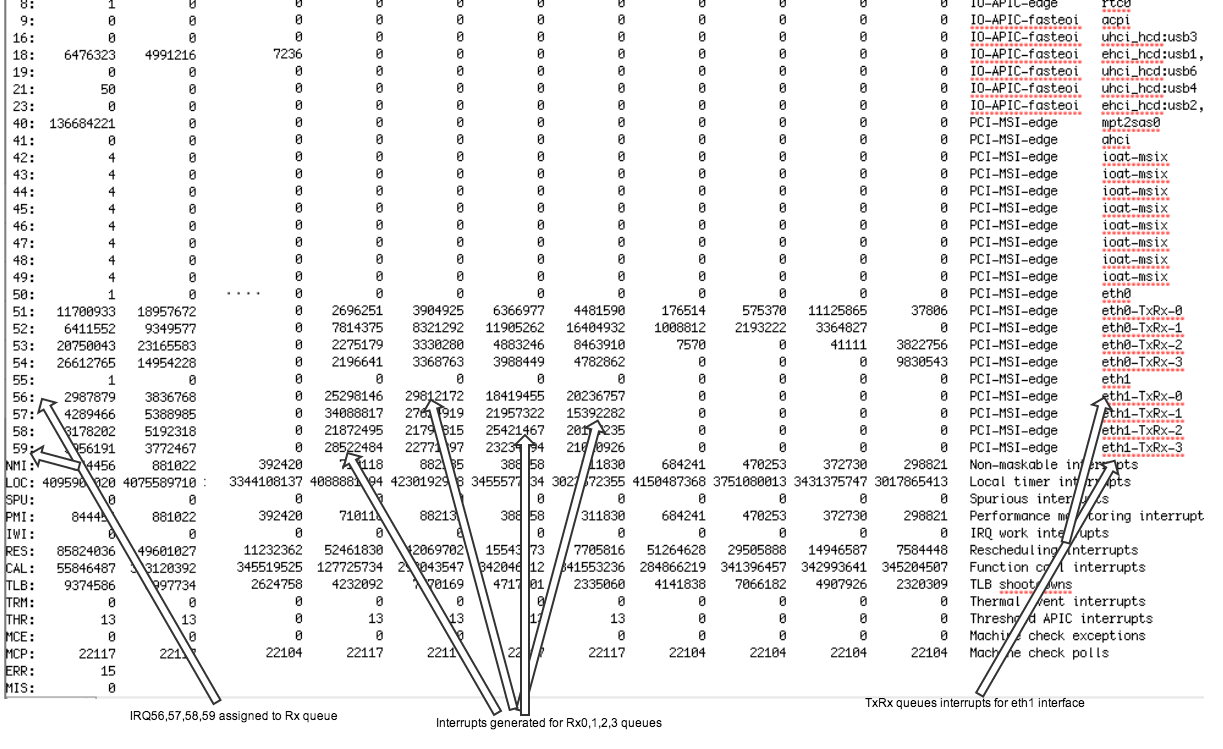.png)
RSS provides the benefits of parallel receive processing in multiprocessing environment.
This is NIC technology. It supprots multiple queues and integrates a hashing function (distributes packets to different queues by Source and Destination IP and if applicable by TCP/UDP source and destination ports) in the NIC. The NIC computes a hash value for each incoming packet. Based on hash values, NIC assigns packets of the same data flow to a single queue and evenly distributes traffic flows across queues.
Check with
ethool -Lcommand.According Linux kernel documentation,
RSS should be enabled when latency is a concern or whenever receive interrupt processing froms a bottleneck... For low latency networking, the optimal setting is to allocate as many queues as there are CPUs in the system (or the NIC maximum, if lower).

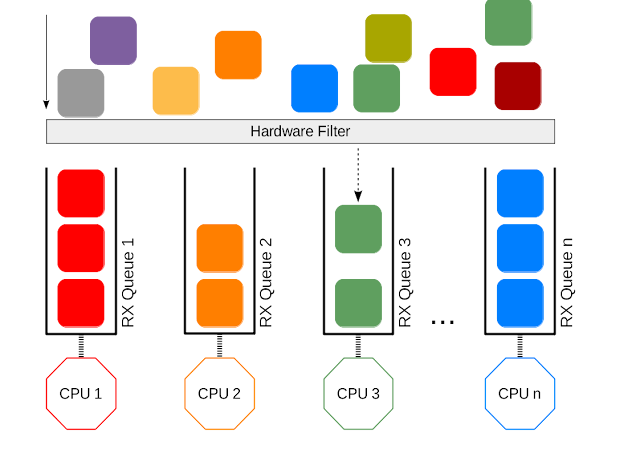
- // WIP - Commands!
Receive Packet Steering (RPS)
- RPS is logically a software implementation of RSS. Being in software, it is necesarily called later in the datapath. Whereas RSS selects the queue and hence CPU that will run the hardware interrupt handler, RPS selects the CPU to perform protocol processing above the interrupt handler.
- When the driver receives a packet, it wraps the packet in a socket buffer
sk_buffwhich contains au32hash value for the packet (based on source IP, source port, dest IP, dest port). Since every packet of the same TCP/UDP connection (flow) shares the same hash, it’s reasonable to process them with the same CPU. After that, it will reach eithernetif_rx_internal()ornetif_receive_skb_internal(), and thenget_rps_cpu()will be invoked to map the hash to an entry inrps_map, i.e. the CPU id. After getting the CPU id,enqueue_to_backlog()puts the sk_buff to the specific CPU queue for the further processing. The queues for each CPU are allocated in the per-cpu variable,softnet_data.
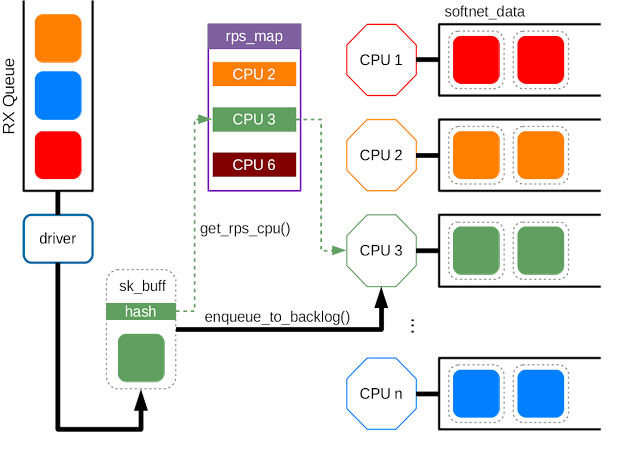
- The benefit of using RPS is same as RSS: share the load of packet processing among the CPUs.
- It may be unnecessary if RSS is availble.
- If there are more CPUs than the queues, RPS could still be useful.
- RPS requires a kernel compiled with the
CONFIG_RPSkconfig symbol (on by default for SMP). Even when compiled, RPS remains disabled until explicitly configured. The list of CPUs to which RPS may forward traffic can be configured for each receive queue using sysfs file entry:
/sys/class/net/<dev>/queues/rx-<n>/rps_cpus
# This file implements a bitmap of CPUs
# 0 (default): disabled
- Suggested configuration:
- Single queue device:
rps_cpus- the CPUs in the same memory domain of the interrupting CPU. If NUMA locality is not an issue,rps_cpus- all CPUs in the system. At high interrupt rate, it might be wise to exclude the interrupting CPU from the map since that already performs much work. - Multi-queue system: if RSS is configured -> RPS is redundant and unnecessary. If there are fewer hardware queues than CPUs, then RPS might be beneficial if the
rps_cpusfor each queue are the ones that share the same memory domain as the interrupting CPU for that queue.
- Single queue device:
Receive Flow Steering (RFS)
- Although RPS distributes packets based on flows, it doesn’t take the userspace applications into consideration.
- The application may run on CPU A, kernel puts the packets in the queue of CPU B.
- CPU A can only use its own cache, the cached packets in CPU B become useless.
- RFS extends RPS further for the applications.
- RFS is only available if the kconfig symbol
CONFIG_RPSis enabled. - Instead of the per-queue hash-to-CPU map, RFS maintains a global flow-to-CPU table,
rps_sock_flow_table. The size of this table can be adjusted:
sysctl -w net.core.rps_sock_flow_entries 32768
Although the socket flow table improves the application locality, it also raise a problem. When the scheduler migrates the application to a new CPU, the remaining packets in the old CPU queue become outstanding, and the application may get the out of order packets. To solve the problem, RFS uses the per-queue
rps_dev_flow_tableto track outstanding packets.- The size of the per-queue flow table
rps_dev_flow_tablecan configured through sysfs interface:/sys/class/net/<dev>/queues/rx-<n>/rps_flow_cnt.
- The size of the per-queue flow table
The next steps is way too complicated, if you want to know it, check this out.
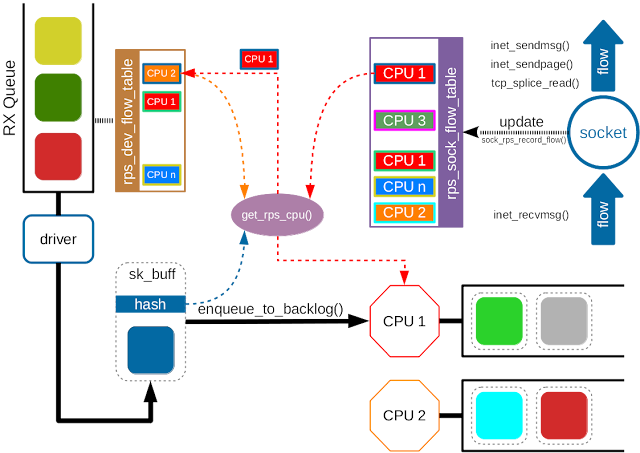
- Suggested configuration:
- The suggested flow count depends on the expected number of active connections at any given time, which may be significantly less than the number of the connections ->
32768forrps_sock_flow_entries. - Single queue device:
rps_flow_cnt=rps_sock_flow_entries. - Multi-queue device:
rps_flow_cnt(each queue) =rps_sock_flow_entries / N(N is the number of queues).
- The suggested flow count depends on the expected number of active connections at any given time, which may be significantly less than the number of the connections ->
Accelerated Receive Flow Steering (aRFS)
- Accelerated RFS is to RFS what RSS is to RPS: a hardware-accelerated load balancing mechanism that uses soft state to steer flows based on where the application thead consuming the packets of each flow is running.
- aRFS should perform better than RFS since packets are sent directly to a CPU local to the thread consuming the data.
- aRFS is only available if the following conditions are met:
- aRFS must be supported by the network interface card (export the
ndo_rx_flow_steernetdevice function) ntuplefiltering must be enabled.- The kernel is compiled with
CONFIG_RFS_ACCEL.
- aRFS must be supported by the network interface card (export the
- The map of CPU to queues is automatically deduced from the IRQ affinities configured for each receive queue by the driver, so no additional configuration should be necessary.
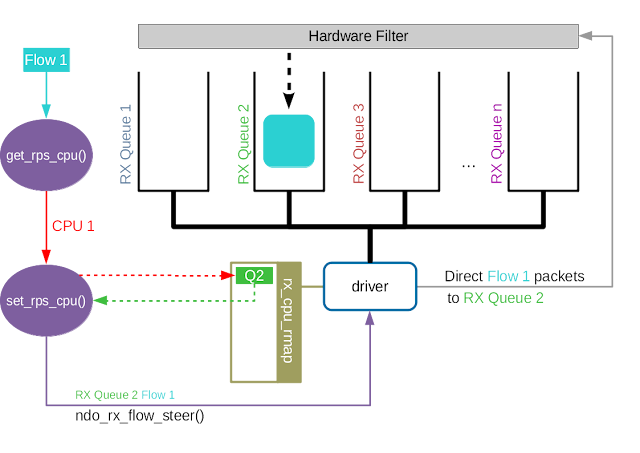
- Suggested configuration:
- Enabled whenever one wants to use RFS and the NIC supports hardware acceleration .
Interrupt Coalescing (soft IRQ)
net.core.netdev_budget_usecs:Tuning:
- Change command:
sysctl -w net.core.netdev_budget_usecs <value>- Persist the value, check this
net.core.netdev_budget:Tuning:
- Change command:
sysctl -w net.core.netdev_budget <value>- Persist the value, check this
- How to monitor:
- If any of columns beside the 1st column are increasing, need to change budgets. Small increments are normal and do not require tuning.
cat /proc/net/softnet_stat
net.core.dev_weight:Tuning:
- Change command:
sysctl -w net.core.dev_weight <value>- Persist the value, check this
- How to monitor:
cat /proc/net/softnet_stat
Ingress QDisc
In step (14), I has mentioned
netdev_max_backlog, it’s about Per-CPU backlog queue. Thenetif_receive_skb()kernel function (step (12)) will find the corresponding CPU for a packet, and enqueue packets in that CPU’s queue. If the queue for that processor is full and already at maximum size, packets will be dropped. The default size of queue -netdev_max_backlogvalue is 1000, this may not be enough for multiple interfaces operating at 1Gbps, or even a single interface at 10Gbps.Tuning:
Change command:
- Double the value -> check
/proc/net/softnet_stat - If the rate is reduced -> Double the value
- Repeat until the optimum size is established and drops do not increment
sysctl -w net.core.netdev_max_backlog <value>- Double the value -> check
Persist the value, check this
How to monitor: determine whether the backlog needs increasing.
- 2nd column is a counter that is incremented when the netdev backlog queue overflows.
cat /proc/net/softnet_stat
Egress Disc - txqueuelen and default_qdisc
In the step (11) (transimission), there is
txqueuelen, a queue/buffer to face conection bufrst and also to apply traffic control (tc).Tuning:
- Change command:
ifconfig <interface> txqueuelen value- How to monitor:
ip -s link # Check RX/TX dropped?You can change
default_qdiscas well, cause each application has diffrent load and need to traffic control and it is used also to fight against bufferfloat.The can check this article - Queue Disciplines section.Tuning:
- Change command:
sysctl -w net.core.default_qdisc <value>- Persist the value, check this
- How to monitor:
tc -s qdisc ls dev <interface> # Example qdisc fq_codel 0: root refcnt 2 limit 10240p flows 1024 quantum 1514 target 5ms interval 100ms memory_limit 32Mb ecn drop_batch 64 Sent 33867757 bytes 231578 pkt (dropped 0, overlimits 0 requeues 6) # Dropped, overlimits, requeues!!! backlog 0b 0p requeues 6 maxpacket 5411 drop_overlimit 0 new_flow_count 1491 ecn_mark 0 new_flows_len 0 old_flows_len 0
TCP Read and Write Buffers/Queues
Define what is memory pressure is specified at
tcp_memandtcp_moderate_rcvbuf.We can adjust the mix-max size of buffer to improve performance:
- Change command:
sysctl -w net.ipv4.tcp_rmem="min default max" sysctl -w net.ipv4.tcp_wmem="min default max"- Persist the value, check this
- How to monitor: check
/proc/net/sockstat.
TCP FSM and congestion algorithm
Accept and SYN queues are governed by net.core.somaxconn and net.ipv4.tcp_max_syn_backlog. Nowadays net.core.somaxconn caps both queue sizes.
net.core.somaxconn: provides an upper limit on the value of the backlog parameter passed to thelisten() function, known in userspace is asSOMAXCONN. If you change this value, you should also change your application to a compatible value. You can check Envoy’s performance tuning note.net.ipv4.tcp_fin_timeout: specifies the number of seconds to wait for a final FIN packet before the socket is forcibly closed.net.ipv4.tcp_available_congestion_control: shows the available congestion control choices that are registered.net.ipv4.tcp_congestion_control: sets the congestion control algorithm to be used for new connections.net.ipv4.tcp_max_syn_backlog: sets the maximum number of queued connection requests which have still not received an acknowledgment from the connecting client; if this number is exceeded, the kernel will begin dropping requests.net.ipv4.tcp_syncookies: enables/disables syn cookie, useful for protecting against syn flood attacks.net.ipv4.tcp_slow_start_after_idle: enables/disables tcp slow start.

- You may want to check Broadband tweaks note.
NUMA
- This term is beyond network performance aspect.
- Non-uniform memory access (NUMA) is a kind of memory architecture that allows a processor faster access to contents of memory than other traditional techniques. In other words, a processor can access local memory much faster than non-local memory. This is because in a NUMA setup, each processor is assigned a specific local memory exclusively for its own use. This elimates sharing of non-local memory, reducing delays (fewer memory locks) when multiple requests come in for access to the same memory location -> Increase nework performance (cause CPUs have to access ring buffer (memory) to process data packet)

- NUMA architecture splits a subset of CPU, memory, and devices into different “nodes”, in effect creating multiple small computers with a fast interconnect and common operating system. NUMA systems need to be tuned differently to non-NUMA system. For NUMA, the aim is to group all interrupts from the devices in a single node onto the CPU cores belonging to that node.
- Although this appears as though it would be useful for reducing latency, NUMA systems have been known to interact badly with real time applications, as they can cause unexpected event latencies.
- Determine NUMA nodes:
ls -ld /sys/devices/system/node/node*
drwxr-xr-x. 3 root root 0 Aug 15 19:44 /sys/devices/system/node/node0
drwxr-xr-x. 3 root root 0 Aug 15 19:44 /sys/devices/system/node/node1
- Determine NUMA locality:
cat /sys/devices/system/node/node0/cpulist
0-5
cat /sys/devices/system/node/node1/cpulist
# empty
- It makes sense to tune IRQ affinity for all CPUs, make sure that you sudo systop
irqbalanceservice and manually setting the CPU affinity:
systemctl stop irqbalance
Determine device locality:
- Check the whether a PCIe network interface belongs to a specific NUMA node. The command will display the NUMA node number, interrupts for the device should be directed to the NUMA node that the PCIe device belongs to
# cat /sys/class/net/<interface>/device/numa_node cat /sys/class/net/eth3/device/numa_node 1 # -1 - the hardware platform is not actually NUMA and the kernel is just emulating # or 'faking' NUMA, or a device is on a bus which does not have any NUMA locality, # such as a PCI packageThe Linux kernel has supported NUMA since version 2.5 - RedHat, Debian-based offer NUMA support for process optimization with the two software packages
numactlandnumad.numadis a daemon which can assist with process and memory management on system with NUMA architecture. Numad achieves this by monitoring system topology and resource usage, then attempting to locate processes for efficent NUMA locality and efficiency, where a process hash a sufficiently large memory size and CPU load.
systemctl enable numad systemctl start numadnumadctl: control NUMA policy for processes or shared memory.
Further more - Packet processing
This section is an advance one. It introduces some advance module/framework to achieve high performance.
AF_PACKET v4
Source:
New fast packet interfaces in Linux:
AF_PACKET v4No system calls in data path
Copy-mode by default
True zero-copy mode with
PACKET_ZEROCOPY, DMA packet buffers mapped to user space.- To better understand the solution to a problem, we first need to understand the problem itself.
- This sample is taken from IBM article.
- Scenario: Read from a file and transfer the data to another program over the network.
File.read(fileDesc, buf, len); Socket.send(socket, buf, len);- The copy operation requires 4 context switches between user mode and kernel mode, and the data is copied 4 times before the operation is complete.

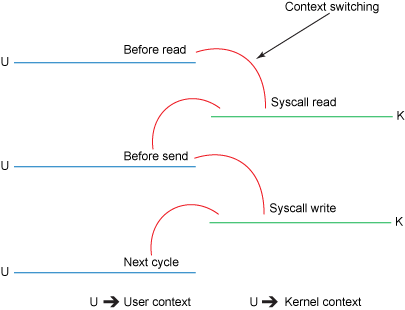
- Zero copy improves performance by elimninating these redundant data copies.
- You’ll notice that the 2nd and 3rd copies are not actually required (The application does nothing other than cache the data and transfer it back to the socket buffer) -> The data could be transfered directly from the read buffer to the socket buffer -> Use method
transferTo(), assume that this method transfers data from the file channel to the given writable byte channel. Internally, it depends on the OS’s support for zero copy (in Linux, UNIX, this sissendfile()system call).
#include <sys/socket.h> ssize_t sendfile(int out_fd, int in_fd, off_t *offset, size_t count);public void transferTo(long position, long count, WritableByteChannel target); // Copy data from a disk file to a socket transferTo(position, count, writableChannel);
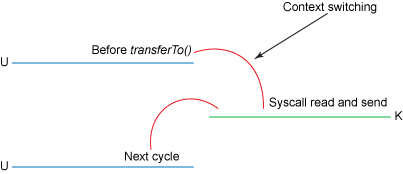
- Gather operations: In Linux kernels 2.4 and later, the socket buffer descriptor was modified to acommondata this requirement. This approach not only reduces multiple context switches but also eliminates the duplicated data copies that require CPU involvement.
- No data is copied into the socket buffer. Instead, only descriptors with information about the location and length of the data are appended to the socket buffer. The DMA engine passes data directly from the kernel buffer to the protocol engine, thus elimianting the remaining final CPU copy.

HW descriptors only mapped to kernel
In order to improve Rx and Tx performance this implementation make uses
PACKET_MMAP.
PACKET_MMAP
Source:
PACKET_MMAPis a Linux API for fast packet sniffing.It provides a mmapped ring buffer, shared between user space and kernel, that’s ued to send and receive packets. This helps reducing system calls and the copies needed between user space and kernel.
Kernel bypass: Data Plane Development Kit (DPDK)
Source:
https://www.cse.iitb.ac.in/~mythili/os/anno_slides/network_stack_kernel_bypass_slides.pdf
https://selectel.ru/blog/en/2016/11/24/introduction-dpdk-architecture-principles/
The kernel is insufficient:
To understand the issue, check this slide.
Performance overheads in kernel stack:
- Context switch between kernel and userspace

- Packet copy between kernel and userspace

- Dynamic allocation of
sk_buff - Per packet interrupt
- Shared data structures
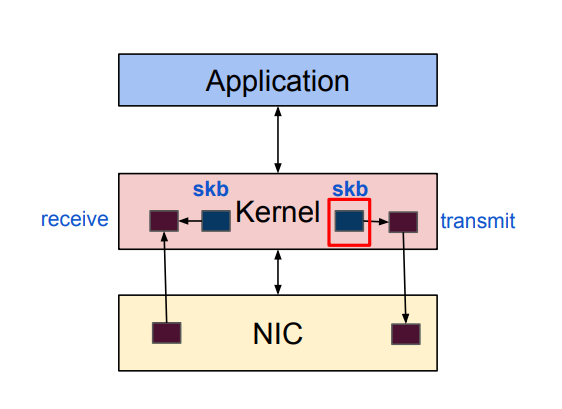
Solution: Why just bypass the kernel?
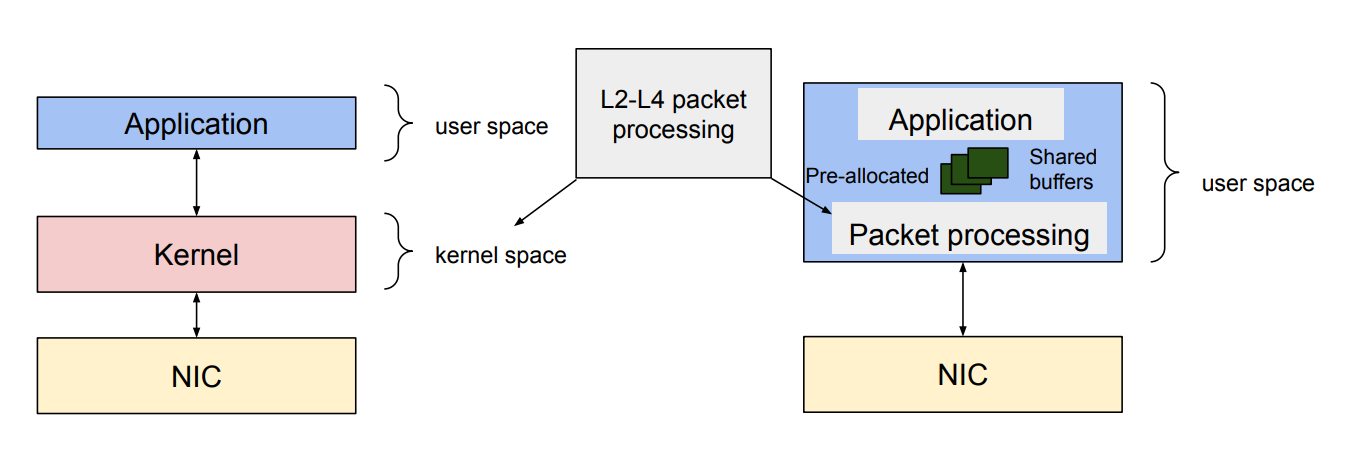
- There are many kernel bypass techniques:
- User-space packet processing:
- Data Plane Development Kit (DPDK)
- Netmap
- …
- User-space network stack
- mTCP
- …
- User-space packet processing:
- But I only talk about the DPDK, as it’s the most popular.
DPDK (Data Plane Development Kit):
A framework comprised of various userspace libraries and drivers fast packet processing.
Goal: forward network packet to/from Network Interface Card (NIC) from/to user application at native speed (fast packet processing).
- 10 or 40Gb NICs
- Speed is the most important criteria
- Only forward the packet - not a network stack
All traffic bypasses the kernel:
- When a NIC is controlled by a DPDK driver, it’s invisible to the kernel
Open source (BSD-3 for most, GPL for Linux Kernel related parts)
How it works:
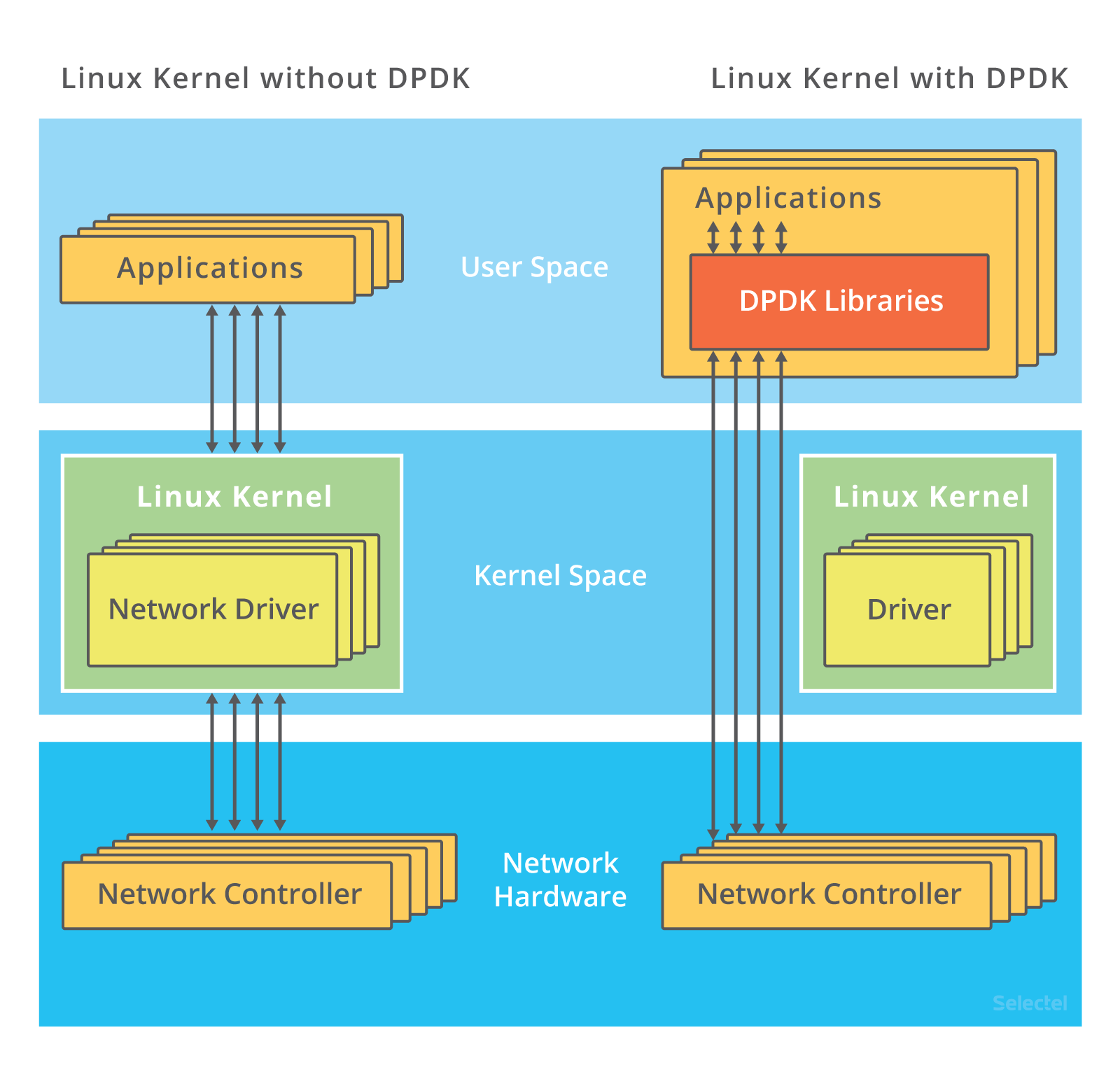
- The kernel doesn’t step in at all: interactions with the network card are performed via special drivers and libraries
- The ports receiving incoming traffic on network cards need to be unbound from Linux (the kernel driver). This is done using the
dpdk_nic_bind(ordpkg-devbind) command, or./dpdk_nic_bind.pyin earlier versions. - How are ports then managed by DPDK? Every driver in Linux has bind and unbind files:
ls /sys/bus/pci/drivers/ixgbe bind module new_id remove_id uevent unbind- To unbind a device from a driver, the device’s bus number needs to be written to the unbind files. Similarly, to bind a device to another driver, the bus number needs to be written to its bind file. More detailed information about this can be found here.
- The DPDK installation instructions tell that ports need to be managed by the vfio_pci, igb_uio, or uio_pci_generic driver.
- These drivers make it possible to interact with devices in the user space. Of course they include a kernel module, but that’s just to initialize devices and assign the PCI interface.
- All further communication betwene the application and network card is organized by the DPDK PMD.
- DPDK also requires hugepages be configured. This is required for allocating large chunks of memory and writing data to them (same job that DPDK does in traditional packet processing)
- Main stage:
- Incoming packets go to a ring buffer. The application periodically checks this buffer for new packets
- If the buffer contains new packet descriptors, the application will refer to the DPDK packet buffers in the specially allocated memory pool using the pointers in the packet descriptors.
- If the ring buffer does not contain any packets, the application will queue the network devices under the DPDK and then refer to the ring again.
Components:
- Core components:
- Environment Abstraction Layer (EAL): provides a generic interface that hides the environment specifics from the applications and libraries.
- Ring Manager (
librte_ring): the ring structure provides a lockless multi-producer, multi-consumer FIFO API in a finite size table. - Memory Pool Manager (
librte_mempool): is responsible for allocating pools of objects in memory.- A pool is identified by name and uses a ring to store free objects.
- Provide some optional services, such as a per-core object cache and an alignment helper to ensure that objects are padded to spread them equally on all RAM channels.
- Network Packet Buffer Management (
librte_mbuf):- mbuf library provides the facility to create and desctroy buffers that may be used by the DPDK application to store message buffers (created at startup time and stored in a mempool)
- Provides an API to allocate/free mbufs, manipulate packet buffers which are used to carry network packets.
- Timer Manager (
librte_timer): Provides a timer service to DPDK execution units, providing the ability to execute a function asynchronously.
- Poll Mode Drivers: Instead of the NIC raising an interrupt to the CPU when a frame is received, the CPU runs a poll mode driver (PMD) to constantly poll the NIC for new packets. However, this does mean that a CPU core must be dedicated and assigned to running PMD. However, this does mean that a CPU core must be dedicated and assigned to running PMD. The DPDK includes Poll Mode Drivers (PMDs) for 1 GbE, 10 GbE and 40GbE, and para virtualized virtio Ethernet controllers which are designed to work without asynchronous, interrupt-based signaling mechanisms.
- Packet Forwarding Algorithm Support: The DPDK includes Hash (
librte_hash) and Longest Prefix Match (LPM,librte_lpm) libraries to support the corresponding packet forwarding algorithms. librte_net: a collection of IP protocol definitions and convenience macros. It is based on code from the FreeBSD* IP stack and contains protocol numbers (for use in IP headers), IP-related macros, IPv4/IPv6 header structures and TCP, UDP and SCTP header structures.
- Core components:
Limitations:
- Heavily hardware reliant.
- A CPU core must be dedicated and assigned to running PMD. 100% CPU.
PF_RING
Source:
https://repository.ellak.gr/ellak/bitstream/11087/1537/1/5-deri-high-speed-network-analysis.pdf
https://www.synacktiv.com/en/publications/breaking-namespace-isolation-with-pf_ring-before-700.html
PF_RING is a Linux kernel module and user-space framework that allows you to process packets at high-rates while providing you a consistent API for packet processing applications.
PF_RINGis polling packets from NICs by means of Linux NAPI. This means that NAPI copies packets from the NIC to thePF_RINGcircular buffer, and then the userland application reads packets from ring. In this scenario, there are 2 pollers, both the application and NAPI and thjis results in CPU cucles used for this polling -> Advantage:PF_RINGcan distribute incoming packets to multiple rings simultaneously.
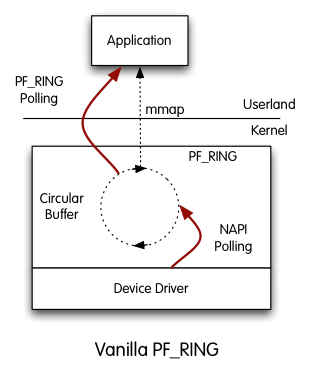
PF_RINGhas a modular architecture that makes it possible to use additional components other than the standardPF_RINGmodule.- ZC module (Zero Copy):
- FPGA-based card modules: add support for many vendors
- Stack module: can be used to inject packets to the linux network stack
- Timeline module: can be used to seamlessly extract traffic from a n2disk dump set using the
PF_RING API - Sysdig module: captures system events using the sysdig kernel module

- Benefits:
- It creates a straight path for incoming packets in order to make them first-class citizens
- No need to use custom network cards: any card is supported
- Transparent to applications: legacy applications need to be recompiled in order to use it
- No kernel or low-level programming is required
- Developer familiar with network applications can immediately take advantage of it without having to learn new APIs
PF_RINGhas reduced the cost of packet capture and forward to userland. However it has some design limitations as it requires two actors for capturing packets that result in sub-optimal performance:- kernel: copy packet from NIC to ring
- userland: read packet from ring and process it
PF_RINGsince version 7.5 includes support forAF_XDPadapters, when compiling from source code this is enabled by default.
Programmable packet processing: eXpress Data Path (XDP)
Source:
https://blogs.igalia.com/dpino/2019/01/10/the-express-data-path/
https://github.com/iovisor/bpf-docs/blob/master/Express_Data_Path.pdf
https://github.com/xdp-project/xdp-paper/blob/master/xdp-the-express-data-path.pdf
http://vger.kernel.org/lpc_net2018_talks/lpc18_paper_af_xdp_perf-v2.pdf
https://people.netfilter.org/hawk/presentations/KernelRecipes2018/XDP_Kernel_Recipes_2018.pdf
XDP (eXpress Data Path):
An eBPF implementation for early packet interception. It’s programmable, high performance, specialized application, packet processor in Linux networking data path.
- eBPF is the user-defined, sandboxed bytecode executed by the kernel. For more check out.
- Evolution from former BPF version (cBPF, used by tcpdump)
- 11 registers (64-bit), 512 bytes stack
- Read and write access to context (for networking: packets)
- LLVM backend to compile from c to eBPF (or from Lua, go, P4, Rust,…)
- In-kernel verifier to ensure safety, security
- JIT (Just-in-time) compiler available for main architecture
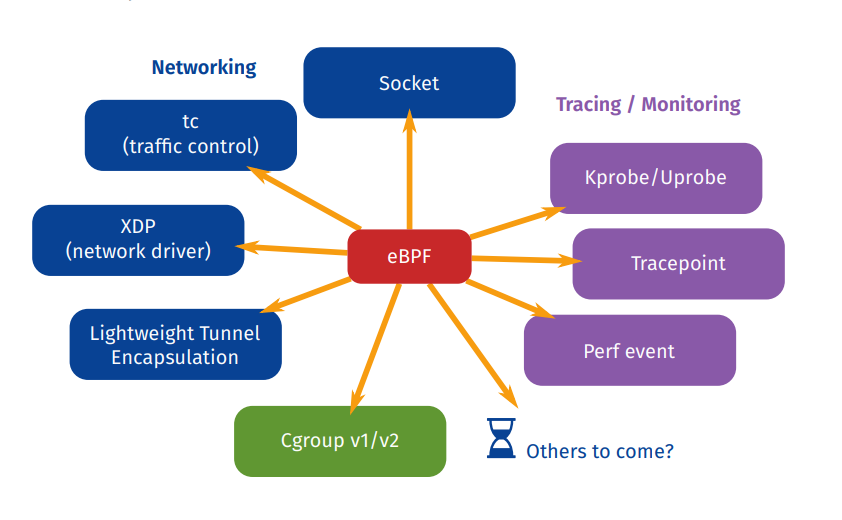
- Features:
- Maps: key-value entries (hash, array,…) shared between eBPF programs or with user user-space
- Tail calls: “long jump” from one program into an other, context is preserved
- Helpers; white-list of kernel functions to call from eBPF programs: get current time, print debug information, lookup or update maps, shrink or grow packets,…
Bare metal packet processing at lowest point in the SW network stack.
- Before allocating SKBs
- Inside device drivers RX function
- Operate directly on RX packet-pages

- Use cases:
- Pre-stack processing like filtering to do DOS mitigation
- Forwarding and load balancing
- Batching techniques such as in Generic Receive Offload (GRO)
- Flow sampling, monitoring
- ULP processing
- Properties:
- XDP is designed for high performance
- …and programmability: New functionality can be implemented on the fly without needing kernel modification
- XDP is NOT kernel bypass:
- It’s an integrated fast path in kernel stack.
- If the traditional kernel network stack is a freeway, kernel bypass is a proposal to build an infrastructure of high speed trains and XDP is a proposal for adding carpool lanes to the freeway - Tom Herbert and Alexei Starovoitov.
- XDP does NOT replace the TCP/IP stack.
- XDP does NOT require any specialized hardware, but there are a few hardware requirements:
- Multi-queue NICs
- Common protocol-generic offloads:
- TX/RX checksum offload
- Receive Side Scaling (RSS)
- Transport Segmentation Offload (TSO)
- LRO, aRFS, flow hash from device are “nice to have"s
Compare to DPDK:
- XDP is a young project, but very promising.
- Advantages of XDP over DPDK:
- Allow option of busy polling or interrupt driven networking
- No need to allocate huge pages
- No special hardware requirements
- Dedicated CPUs are not required, user has many options on how to structure the work between CPUs
- No need to inject packets into the kernel from a 3rd party userspace application
- No need to define a new security model for accessing networking HW
- No 3rd party code/licenseing required.
XDP packet processor:

- In kernel
- Component that processes RX packets
- Process RX “packet pages” directly out of driver
- Functional interface
- No early allocation of skbuff’s, no SW queues
- Assign one CPU to each RX queue
- No locking RX queue
- CPU can be dedicated to busy poll to use interrupt model
- BPF programs performs procesing
- Parse packets
- Perform table lookups, creates/manages stateful filters
- Manipulate packet
- Return action:
- Basic actions:
- Forward:
- Possibly after packet modification
- TX queue is exclusive to same CPU so no lock needed
- Drop:
- Just return error from the function
- Driver recycles pages
- Normal receive:
- Allocate skbuff and receive into stack
- Steer packet to another CPU for processing
- Allow “raw” interfaces to userspace like
AF_PACKET, netmap
- GRO:
- Coalesce packets of same connection
- Perform receive of large packets
- Forward:
AF_XDP: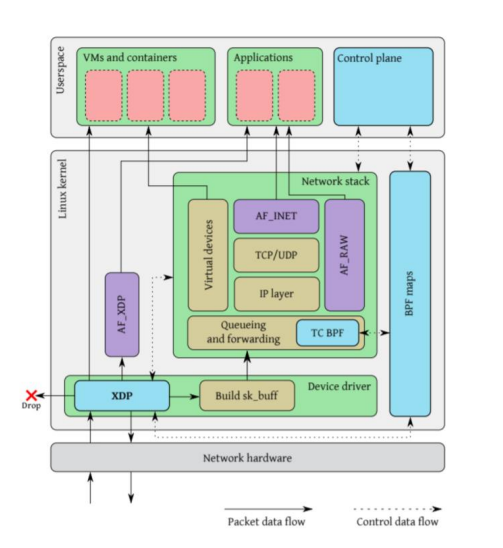
A new type of socket, presented into the Linux 4.18 which does not completely bypass the kernel, but utilizes its functionality and enables to create something alike DPDK or the
AF_PACKET.- An upgraded version of
AF_PACKET: Use XDP program to trigger Rx path for selected queue - XDP programs can redirect frames to a memory buffer in user-space by eBPF -> not bypass the kernel but creates in-kernel fast path.
- DMA transfers use user space memory (zero copy)
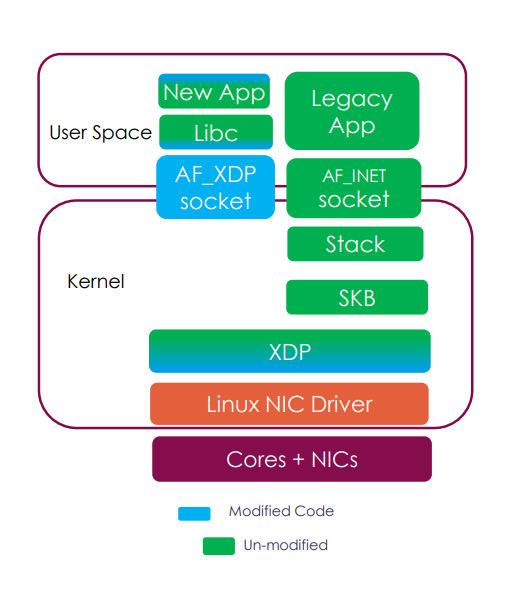
- Benefits:
- Performance improvement:
- Zero copy between user space and kernel space
- Achieve 3-20x times improvement comparing to
AF_PACKET
- Connect the XDP pass-through to user-space directly:
- An eBPF program that processes packets can be forwarded to an application in a very efficient way
- For DPDK:
- No change to DPDK apps, kernel driver handles hardware
- Provide a new option for users
- Performance improvement:
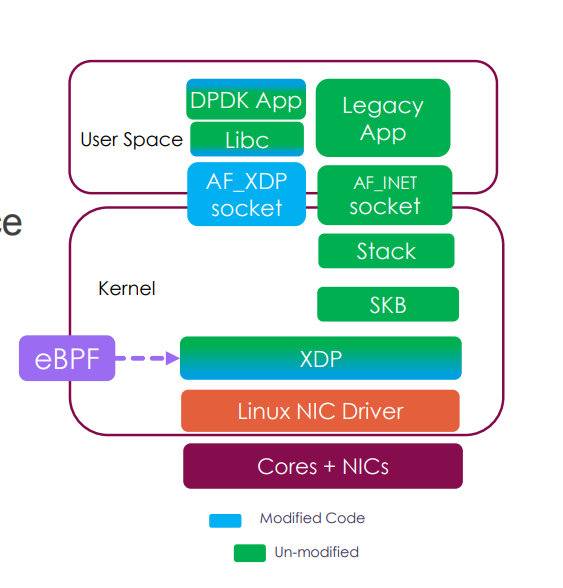
- An upgraded version of
Limitations:
- Quite young project
- Require a new kernel version (>= 5.4) to fully support.
